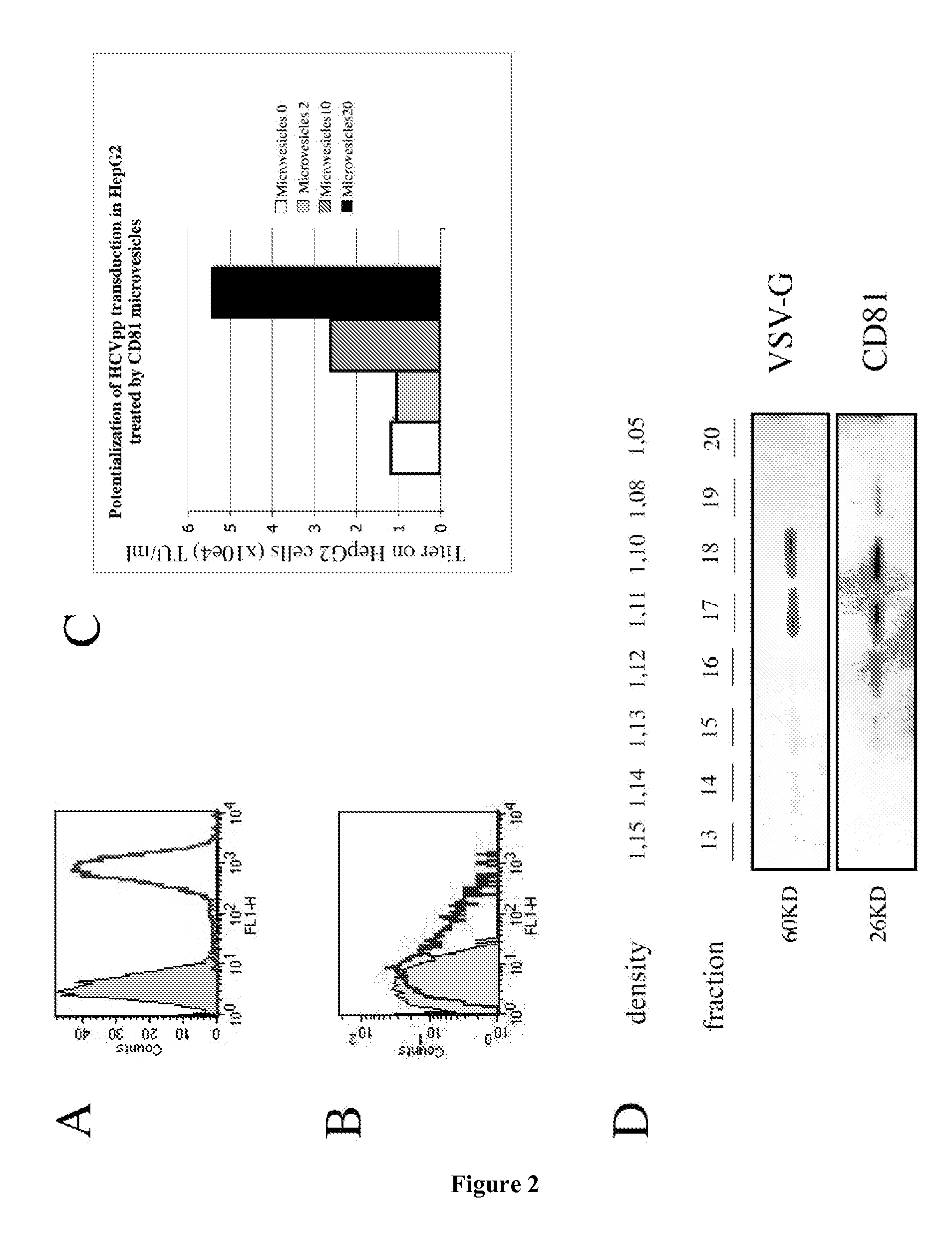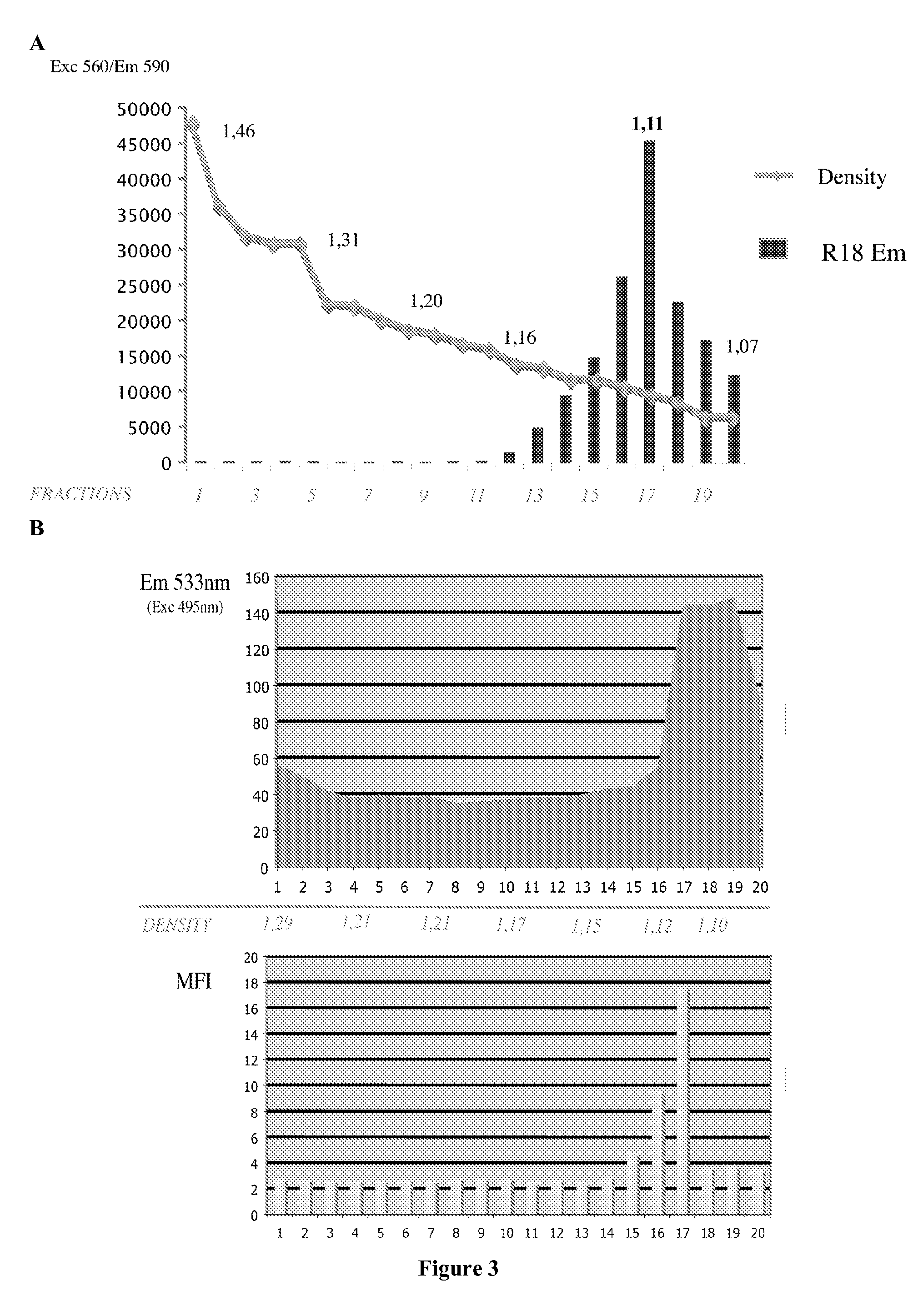Direct protein delivery with engineered microvesicles
a technology of microvesicles and direct protein, which is applied in the direction of viruses/bacteriophages, antibody medical ingredients, peptide sources, etc., can solve the problems of limiting their use, undesirable effects, and slow expression of desired proteins
- Summary
- Abstract
- Description
- Claims
- Application Information
AI Technical Summary
Benefits of technology
Problems solved by technology
Method used
Image
Examples
example 1
[0165]Abstract
[0166]The present example describes the engineering of exosome-like vesicles coated with the G glycoprotein of the Vesicular Stomatitis Virus (VSV-G) and used to deliver exogenous proteins in human target cells. These particles sediment at a density of 1.1 g / ml and can efficiently package cytoplasmic and membrane proteins as well as transcription factors. Model molecules including the membrane mCAT-1 protein and the tet transactivator were efficiently delivered in human target cells upon microvesicles treatment. Vesicle-mediated pseudotransduction led to transient protein expression and was not due to transfer of mRNA or DNA. We showed that chloroquine, a drug raising endosomal pH, invalidated protein transfer indicating that VSV-G induced fusion was involved in the delivery mechanism.
[0167]The VSV-G Fusogenic Envelope is a Key Determinant of Pseudotransduction
[0168]We tested whether expression of VSV-G could lead to the production of particles able to pseudotransduce....
example 2
[0205]Vesicle-mediated protein transfer in a coculture experiment through 3-μm pore sized inserts.
[0206]We cultivated in the same media HEK cells transfected by various combinations of plasmids, together with the Teo-GFP reporter cell line. Cells were separated by a 3-μm pore sized filter as depicted, the producing cells in the bottom of a 6-well dish and the reporter cell line in the top insert. Producing cells were cotransfected with a tTA expression plasmid in addition with a carrier DNA, the VSV-G coding plasmid or a fusion defective VSV-G. After 48 hours of coculture, inserts were removed and the reporter cell line trypsinized and analysed by FACS to evaluate tTA delivery. Results are given as the MFI in the Teo-GFP cell line (FIG. 12).
[0207]This technique enables the delivery of protein into target cells, without the need of a concentration step. Concentrated vesicles can be toxic depending on the target cell type. Target cells can be cultivated in the top or the bottom chambe...
example 3
[0208]Insect Cells Microvesicle Production and Dosage
[0209]Baculovirus production was performed using the Bac-to-Bac Baculovirus expression system (Invitrogen) according to the manufacturer's instructions. Briefly, cDNAs of interest were cloned in the pFAST-1 shuttle prior to recombination in DH10-BAC bacteria. Baculovirus DNAs were next used to transfect SF-9 cells to generate the first baculo stock collected 72 hours later (passage 1). This polyclonal stock was further amplyfied to reach a titer of 1×107 pfu / ml (passage 2) that was stored at 4° C. and used for vesicles production.
[0210]Insect cells microvesicles were produced upon baculovirus infection (MOI 0.5-1) of 200×106 HIGH5 cells cultivated in suspension at 30° C. under agitation in 100 ml of Express-five SFM media supplemented with Glutamine (20 mM) and Penicillin-Streptomycin (25U of penicillin, 25 μg of Streptomycin / nil). 48 hours after inoculation, medium was harvested clarified and filtered twice through a 0.45 μm pore...
PUM
| Property | Measurement | Unit |
|---|---|---|
| size | aaaaa | aaaaa |
| size | aaaaa | aaaaa |
| size | aaaaa | aaaaa |
Abstract
Description
Claims
Application Information
 Login to View More
Login to View More - R&D
- Intellectual Property
- Life Sciences
- Materials
- Tech Scout
- Unparalleled Data Quality
- Higher Quality Content
- 60% Fewer Hallucinations
Browse by: Latest US Patents, China's latest patents, Technical Efficacy Thesaurus, Application Domain, Technology Topic, Popular Technical Reports.
© 2025 PatSnap. All rights reserved.Legal|Privacy policy|Modern Slavery Act Transparency Statement|Sitemap|About US| Contact US: help@patsnap.com



